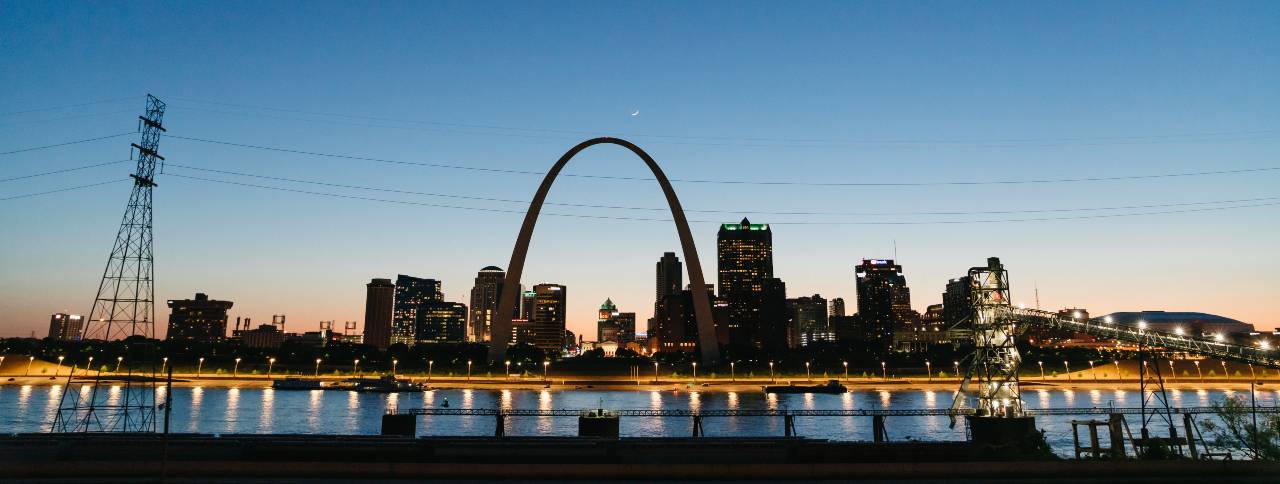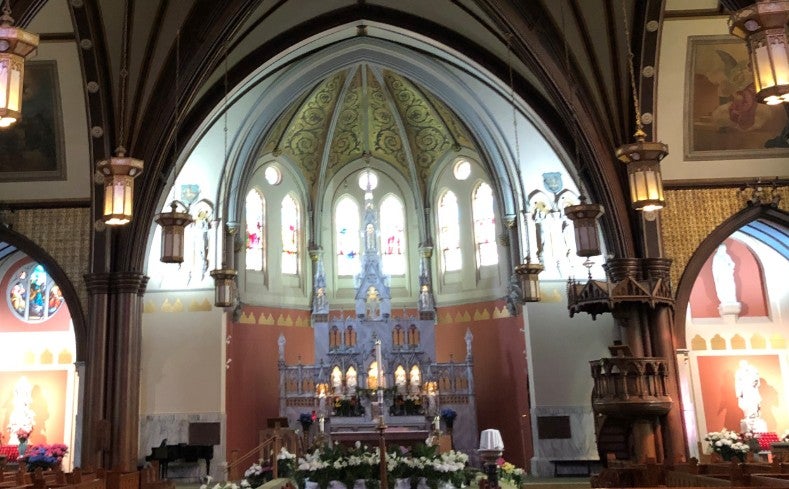Renewable energy, environmental justice, faith communities
Low-income communities and communities of color are disproportionately harmed by air pollution from burning fossil fuels and by the health risks of climate change.
Transitioning away from fossil fuels takes economic and political support, a difficult ask for St. Louis, a city located in a state with one of the highest rates of coal consumption in the country. New technical and scientific funding support from foundations, combined with a recent push by city leaders, religious communities, and clean energy advocates, is putting in place sustainability programs and policies that are moving the Midwest city in a new direction.
As pastor of the New Northside Missionary Baptist Church in St. Louis, the Rev. Rodrick Burton has championed many causes for his church members, from fighting violent crime to helping people struggling to pay their bills.
But one cause stands out for the north St. Louis pastor: promoting clean and affordable renewable energy. As someone with family members who suffer from asthma, Rev. Burton long considered the advantages of solar energy, which does not produce air pollution or greenhouse gases. Six years ago, he took advantage of a state subsidy program that allowed him to install solar panels on his church and community center, which he says saves his congregation $3,000 a year in utility bills. That’s when Rev. Burton really got religion about solar energy.
“Let me be clear — climate change is a civil rights issue,” Rev. Burton wrote in an op-ed at the time. “Low-income communities and communities of color — like the one I serve — are disproportionately harmed by the air pollution from coal-fired power plants, as well as by the heat and health risks due to climate change.”
He joined with environmental groups such as the Sierra Club that wanted to help share his message with a national audience, and he traveled to energy conferences around the country. In 2019, he hosted a summit in St. Louis along with other leaders from the Green the Church movement, a national organization of church leaders focused on environmental justice concerns. Groups like Washington University’s sustainability program helped support the conference. Rev. Burton began thinking up even bigger projects, ones that could provide jobs for his congregants and potentially transform abandoned areas of the city.
While solar installations in disadvantaged urban areas of St. Louis are still rare, across the Mississippi River in Illinois, solar is booming thanks to more supportive energy policies, according to solar installers. Last year, the EPA reached a consent decree in a major Superfund case in East St. Louis that included the construction of solar panels on contaminated property.
“St. Louis has many vacant properties,” Rev. Burton says. “We could make whole areas into solar farms. … Who wants to live next to an abandoned building? We could repurpose the land to create more sustainability projects.”
“Let me be clear — climate change is a civil rights issue.”
For more than a decade, St. Louis Sustainability Director Catherine Werner has been pushing for sustainable development programs designed around three core social, economic and environmental principles. She is seeing real progress around the city’s Climate Protection Initiative after St. Louis was awarded grants to assist with clean energy efforts by the city. One major boost came from Bloomberg Philanthropies, which selected St. Louis for one of its American Cities Climate Challenge grants in 2018. The grant provided critical technical support to accelerate building energy efficiency efforts and to jump-start fledgling renewable energy and vehicle electrification programs.
An April 2021 report issued by the U.S. Conference of Mayors and the Center for Energy and Climate Solutions highlighted St. Louis for its building energy efficiency and solar workforce programs. Werner credits a collaborative effort among many individuals and groups in St. Louis, including educational institutions, nonprofits and community organizations that provided capacity and support for clean energy programs. “I’m delighted that St. Louis has banded together to demonstrate a leadership role,” she says. “The Midwest is a challenging place to implement cIean energy strategies, but if it can be done with the constraints we tend to experience in St. Louis, it can be done anywhere.”
Energy experts who are working with the city say St. Louis still has a long way to go to compete with other cities that have bigger budgets and longer track records with clean energy. But the city is starting to garner attention as an emerging clean energy leader in the Midwest. In a survey by the American Council for an Energy Efficient Economy in 2020, St. Louis was listed as one of the two most improved cities in terms of its energy efficiency programs. The city’s Climate Protection Initiative incorporates several projects designed to meet the city’s goal of becoming carbon neutral by 2050, including climate justice and equity programs.
These programs include a building energy performance standard ordinance adopted by the city in 2020, with technical expertise provided by the Institute for Market Transportation and the Natural Resources Defense Council. The ordinance initially calls for aggressive energy efficiency standards to be met in large buildings — 50,000 or more square feet — and establishes a unique building energy improvement board to oversee its implementation. Buildings account for about 80% of all greenhouse gas emissions in the city, and experts say this is one of the most efficient ways to cut global emissions of greenhouse gases. “It’s not sexy, but this is a tremendous opportunity to reduce emissions,” says Emily Andrews, the executive director of the Missouri Gateway Chapter of the U.S. Green Building Council. “We need to pay attention to this.”
While the building ordinance is still in its early stages, St. Louis has also worked to increase the amount of solar energy available to residents and businesses. The city passed a “solar ready” ordinance in 2019, stipulating that new building construction must allow easy installation of solar panels on commercial and residential buildings. The city also backed a small pilot solar jobs program in 2020 to train workers to install solar panels, and there are plans to expand the program.
Under the city’s former mayor, Lyda Krewson, who left office in April 2021, the city began outfitting its fleet with electric vehicles (EVs), purchasing Chevy Bolts and installing electric chargers to ramp up its plan to increase the number of electric vehicles in the city. It is part of the city’s plan to make EVs more accessible to residents and businesses.
Meanwhile, two nonprofit groups offer discounted solar purchasing opportunities. The Missouri Botanical Garden Earthways Center has a successful residential solarize program, and another nonprofit, Renew STL, facilitates commercial solar purchases. Both programs work with Washington University and the St. Louis solar installer StraightUp Solar. Members of the nonprofit community who are working on these projects are optimistic that the new St. Louis mayor, Tishaura Jones, will continue to support climate programs and will increase the city’s focus on benefits for disadvantaged communities.
While these efforts are still in their infancy, city sustainability director Werner says the key to continued success is focusing sustainability programs on equity and inclusion, critical for a city that is racially divided. “I’ve always viewed my work through an equity lens. If we can’t explain why it makes a difference to local people that they buy renewable energy, then it won’t fly. We have to make it relevant to the people of St. Louis.”
That means making energy programs affordable and providing jobs. And while St. Louis’ solar jobs program is just getting off the ground, some solar companies are adding workers and already see brighter times ahead. Dr. Dane Glueck, an orthopedic surgeon near St. Louis, taught himself how to install solar panels and became the first nationally certified solar installer in Missouri. He founded StraightUp Solar in 2006 after witnessing the negative impacts of coal extraction on land and people’s health in Appalachia. He now runs a company with more than 80 employees who install solar panels in Missouri and Illinois, across the river from St. Louis. His company is committed to carbon neutrality. He expects that StraightUp Solar will continue to grow by at least 10-20% a year, providing jobs not just in installation but in engineering, marketing and accounting as well.
Glueck says he started the company to “do our part to help save the world,” and he sees part of that vision as providing jobs for people in disadvantaged communities. But now with the increasing threats of climate change and growing business and political support for renewable energy, he says it’s never been a better time to be in the solar business. “We are doing this for the greater good,” he says. “Clean energy jobs help empower people through training. There is no better story than that now.”


Meanwhile, St. Louis-based Ameren Corp., a utility long powered by coal, is also moving toward more sustainable energy sources such as solar and wind for its 1.2 million customers. The utility’s most recent integrated resource plan calls for it to have net zero carbon emissions by 2050. That involves retiring several major coal plants and transitioning to more renewable energy sources by the end of the decade, a move that will cut CO2 emissions by 50% by 2030. While Ameren’s energy prices in Missouri are some of the lowest in the country, Ameren executives say they will continue to invest in renewable energy projects that take advantage of new money-saving sustainable technologies. “Our plan delivers cleaner energy to our customers while ensuring continued reliability,” the utility states in its integrated resource plan, “and it does so at the least cost of any of the alternative pathways assessed.”
Missouri legislators have begun to make progress to support clean energy. A securitization bill to help accelerate the retirement of coal plants in the state, The Missouri Electricity Bill Reduction Assistance Act, overwhelmingly passed the Missouri House and Senate and was signed by the governor in July 2021. Environmentalists who pushed for the bill say it could be transformational by allowing utilities to retire coal plants earlier than expected.
Matt Forck, Ameren’s vice president of community, economic development and energy solutions, says the utility is working on a variety of programs with the city to push for new charging networks, energy efficiency programs and development of electric-powered vehicles, as well as for nonprofits working on solar installations. “St. Louis is taking a leadership role in this area,” he says. “I’m very bullish about St. Louis and am an optimist about its future.”
So are people like Maurice Muia, an electrical engineer and utility expert brought in to work with the city under the Bloomberg American Cities Challenge grant. Muia, who formerly worked for Ameren and is a councilman in Richmond Heights near St. Louis, sees a “perfect storm” of opportunity for clean energy programs as demand increases for these kinds of services.
One of the programs he’s most proud of is the St. Louis Electrification Rides for Seniors (SILVERS), a pilot program to bring EVs and clean energy to disadvantaged communities. “These communities have been neglected for decades,” Muia says. “We’re trying to make sure that the underserved communities have the same level of service available in more affluent areas.”
Still, no one is under the illusion that St. Louis’ transition to clean energy will be easy. And environmental and energy experts say utilities should be moving faster to reduce emissions that are driving the increasingly dangerous effects of climate change.
But this may change, especially as significant federal clean energy funding is being discussed as a part of major infrastructure and jobs bills, and as local changes are made. To address the policy side of the equation, one new project is bringing scientific knowledge to Missouri legislators who are working on climate, energy and environmental policies, especially ones that are complex and require detailed research. Rachel Owen, executive director of the Missouri Science and Technology Policy Initiative, has been working with their policy fellows to provide Missouri legislators with short scientific papers (“science notes”), including one on the securitization bill that passed, creating a more supportive financial environment for clean energy. In the first year of the policy initiative, they received requests from legislators for 80 papers on a variety of topics, a pleasant surprise to everyone involved in the new program. They’re also collaborating with the AAAS Local Science Engagement Network to help science advocates engage with civic and policy leaders on locally relevant solutions to climate change and other issues.
David Fike, director of Washington University’s International Center for Energy, Environment and Sustainability, calls the Missouri Science and Technology Policy Initiative a huge step forward. He says at first lawmakers didn’t know what to make of the offer of free information from scientists, and didn’t distinguish them from lobbyists. But that changed as legislators discovered the information was fact-based and nonpartisan. Fike says improving science communication and reaching out to new groups and organizations, such as Rev. Burton’s church in north St. Louis, helps people learn about new technologies that may be available to them.
Rev. Burton agrees. He says people in his community often don’t know about the existence of clean energy programs, but they are eager to learn about cutting their energy costs and taking advantage of new job opportunities. And he’s willing to work with anyone who can help. In 2020, Andrew Wheeler, administrator of the EPA under President Donald Trump, visited with Rev. Burton in St. Louis and worked with church leaders to develop an EPA report on clean energy opportunities for houses of worship. “We need to save our community, no matter who’s in office,” Rev. Burton says.
That attitude is shared by church leaders around the country. The Rev. Dr. Ambrose Carroll, director of the Green the Church program based in Oakland, California, grew up in St. Louis and has worked closely with Rev. Burton. His project includes over a thousand other churches that have participated in clean energy projects and webinars. He believes people from all walks of life play a critical role in getting new energy programs to work.
“Science and technology play a big role in all of this,” Rev. Ambrose says. “But scientists also need people like me to figure out how to translate it to people in our communities. I’ve got to preach it from my head to my heart.”
A version of this film, “Green the City,” was accepted into the 2022 Climate Action Film Festival. 
Story by: Rocky Kistner (July 2021).
Banner Image: St. Louis city lights at night. | Credit: Impact Media Lab / AAAS.




